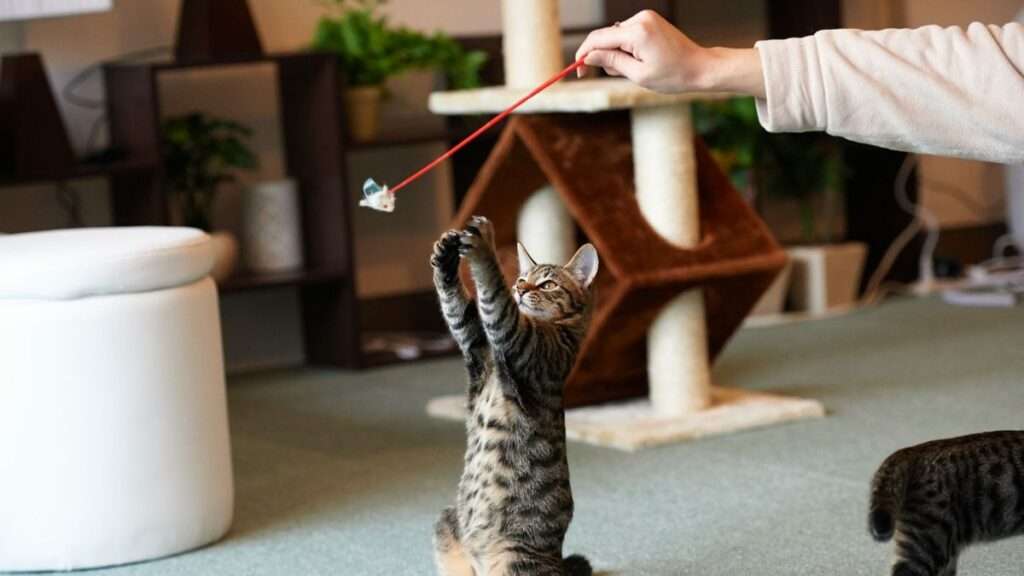Introduction
Disciplining a cat can be challenging, especially since they do not act like dogs. While cats are smart and can learn, they need a unique method based on positive reinforcement, consistency, and patience. This guide explains how to discipline your cat without fear or punishment, and instead, build a relationship based on trust and respect.
Learn more about: When do cats stop growing

Why Do Cats Misbehave?
Cats do not act out of spite. Most unwanted behaviors are either instinctual or due to stress, boredom, or lack of stimulation. Common reasons include:
- Boredom or lack of play
- Territorial instincts
- Medical issues or discomfort
- Anxiety or changes in the home
- Improper litter box setup
Understanding the cause is the first step toward correcting the behavior.
The Golden Rule: Never Use Physical Punishment
Cats do not respond well to yelling, hitting, scruffing, or water spraying. These methods can make them fearful, anxious, or aggressive. Instead, use positive training techniques that help your cat learn what is expected without creating fear.
Effective and Humane Discipline Techniques
Say “No” Calmly and Clearly
Use a firm but non-threatening voice to stop unwanted behavior. Do not yell. Once you have your cat’s attention, redirect them to better behavior.
Redirect Their Attention
If your cat is scratching furniture, gently pick them up and place them near their scratching post. Then reward them for using it.
Use Gentle Deterrents
Discourage unwanted behavior with harmless methods:
- Double-sided tape on counters or furniture
- Aluminum foil or citrus-scented sprays in off-limit areas
- Motion-activated air sprays (safe for pets)
Reward Good Behavior
Positive reinforcement helps shape behavior. Use treats, affection, or toys when your cat behaves appropriately, such as using the litter box or scratching post.
Set Clear Boundaries
Be consistent. Everyone in the household should respond the same way to your cat’s behavior. Mixed messages can confuse your cat and slow progress.
Avoid Reinforcing Bad Behavior
Don’t give attention during negative behavior like biting or climbing on counters. Withdrawing attention (walking away, ignoring) is more effective than scolding.
Training Your Cat to Understand “No”
Cats can learn boundaries, but it may take time.
Here is how to help them understand:
- Use the same cue word every time (e.g. , “No” or “Off”) in a neutral voice
- Combine with a redirection, like showing them a toy or treat
- Be consistent and avoid changing the command
Addressing Specific Behavior Issues
Scratching Furniture
Provide scratching posts in multiple locations. Reward your cat for using them and cover unwanted scratching areas with deterrents.
Jumping on Counters
Discourage access with deterrents and provide alternatives like cat trees or window perches. Avoid leaving food or enticing objects out.
Biting or Aggressive Play
Redirect rough play to toys. Stop the game if biting starts. Use a firm cue like “Ouch! ” and walk away to signal the play session is over.
Litter Box Problems
Ensure the litter box is clean, quiet, and easily accessible. Avoid scented litters or enclosed boxes if your cat dislikes them. Rule out health issues with a vet if accidents continue.
Attention-Seeking Behavior
Increase interactive playtime and offer enrichment activities. If meowing or jumping gets your attention, wait until your cat is calm before engaging.
What to Do When Your Cat Does not Listen
If your cat ignores commands or continues bad behavior:
- Check for medical problems first
- Increase mental and physical stimulation
- Ensure their environment meets their needs (toys, perches, hiding spots)
- Be patient, change takes time and repetition
When to Seek Help
Some behaviors may indicate deeper issues, such as chronic anxiety, territorial aggression, or pain.
If the behavior is persistent or getting worse, consult a veterinarian or certified feline behaviorist. They can help create a tailored plan that addresses your cat’s specific needs.
FAQs
Use calm verbal cues, redirection, and reward-based training. Avoid physical punishment and guide your cat toward acceptable behaviors.
Say “No” in a firm, calm voice. Immediately redirect their behavior and reward them when they follow the cue
Understand what is causing the behavior, offer appropriate outlets, and stay consistent with training.
Use deterrents where needed and reward good behavior.
Review your consistency, environment, and engagement. Increase playtime and stimulation. If needed, seek advice from a behavior specialist.
Conclusion
Disciplining a cat is about patience, understanding, and clear communication.
Rather than punishing unwanted behaviors, focus on teaching your cat the right choices through redirection and rewards. With consistent guidance and compassion, you can build a respectful relationship, and a better-behaved feline companion.


Pingback: Weimaraner Dog Breed: Care, Temperament & Family Fit -